light AUDI A3 2012 Owner´s Manual
[x] Cancel search | Manufacturer: AUDI, Model Year: 2012, Model line: A3, Model: AUDI A3 2012Pages: 280, PDF Size: 70.11 MB
Page 116 of 280
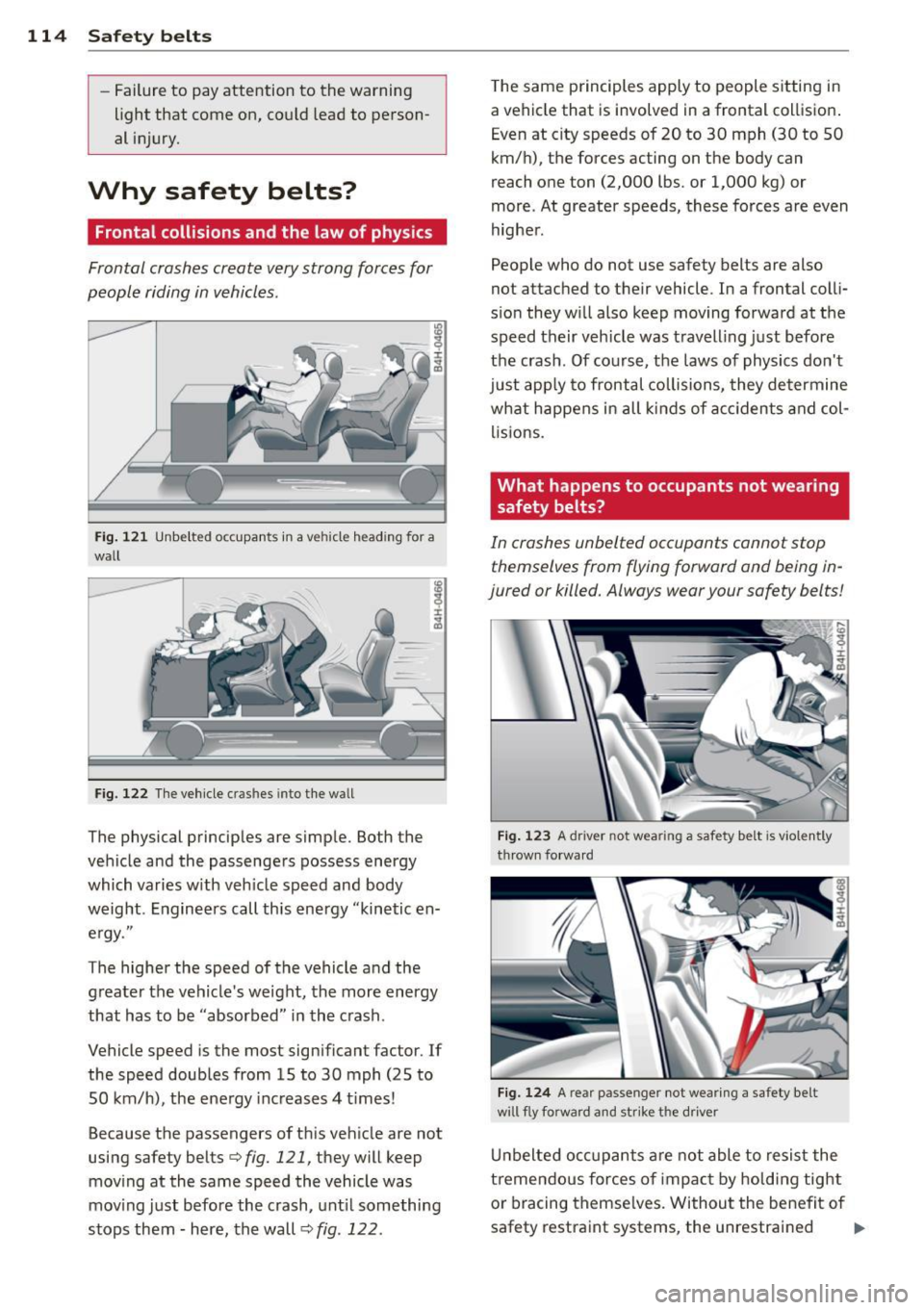
114 Safety belts
-Failure to pay attention to the warning
light that come on, could lead to person
al injury.
Why safety belts?
Frontal collisions and the law of physics
Frontal crashes create very strong forces for
people riding in vehicles.
Fig. 121 Unb elted occupants in a ve hicle heading for a
wall
Fig. 122 Th e vehicle c rash es into the wall
The physical principles are simple. Both the
vehicle and the passengers possess energy
which varies w ith veh icle speed and body
weight . Engineers call this energy "kinetic en
e rgy ."
T he higher the speed of the vehicle and the
greater the vehicle's weight, the more energy
that has to be "absorbed" in the crash .
Vehicle speed is the most significant factor.
If
the speed doubles from 15 to 30 mph (25 to
50 km/h), the energy increases 4 times!
Because the passengers of this vehicle are not
using safety belts
c::;, fig. 121, they will keep
moving at the same speed the vehicle was
mov ing just before the crash, until something
stops them - here, the wall ¢
fig. 122 .
The same principles apply to people sitting in
a vehicle that is involved in a frontal collision .
Even at city speeds of 20 to 30 mph (30 to 50
km/h), the forces acting on the body can
reach one ton (2,000 lbs. or 1,000 kg) or
more . At greater speeds, these forces are even
higher .
Peop le who do not use safety belts are also
not attached to their vehicle. In a frontal colli
s ion they will also keep moving forward at the
speed their vehicle was travell ing just before
the crash . Of course, the laws of physics don't
just apply to frontal collisions, they determine
what happens in all kinds of accidents and col
lisions .
What happens to occupants not wearing
safety belts?
In crashes unbelted occupants cannot stop
themselves from flying forward and being in
jured or killed. Always wear your safety belts!
Fig. 123 A d river not wea ring a safety b elt is viol en tly
thrown fo rwa rd
Fig . 124 A rear passe nge r not wearing a safety belt
w ill fl y forward and strike the dr iver
Unbelted occupants are not able to resist the
tremendous forces of i mpac t by holding tight
or bracing themselves. Without the benefit of
safety restraint systems , the unrestrained
ll-
Page 119 of 280
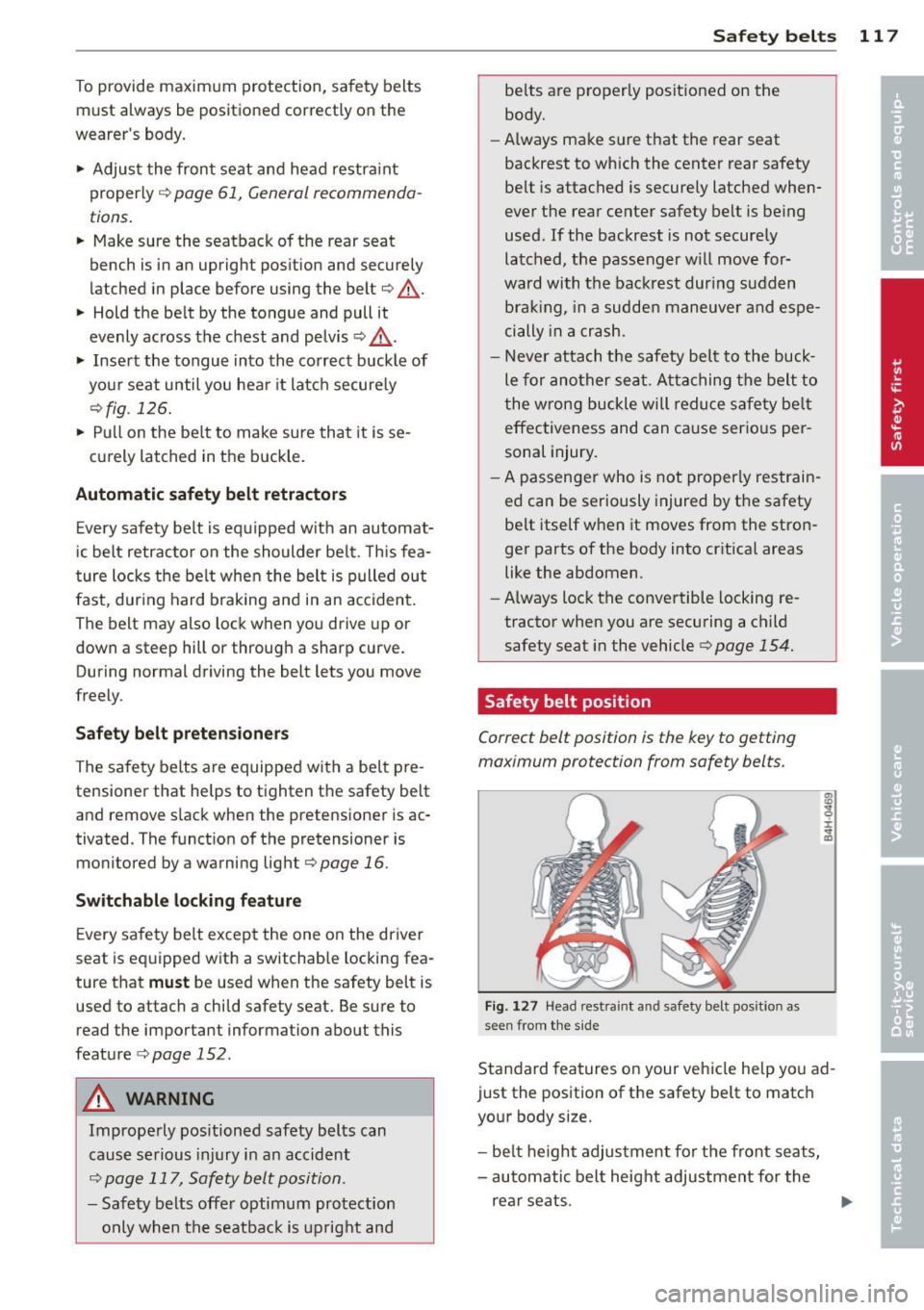
To provide maximum protection, safety belts
must always be positioned correctly on the
wearer's body .
... Adjust the front seat and head restra int
properly
c::> page 61, General recommenda
tions .
... Make sure the seatback of the rear seat
bench is in an upright position and securely
latched in place before using the belt
c::> ,&. .
... Hold the be lt by the tongue and pull it
evenly across the chest and pelvis
c::> ,&..
... Insert the tongue into the correct buckle of
your seat until you hea r it latch securely
c::> fig. 126.
... Pull on t he be lt to make sure that it is se-
curely latched in the buckle.
Automatic safety belt retractors
Every safety belt is equipped w ith an automat
i c belt retractor on the shoulder be lt. This fea
ture locks the be lt when the belt is pulled out
fast, dur ing hard braking and in an accident.
The belt may also lock when you drive up or
down a steep hill or through a sharp curve.
During normal driving the belt lets you move
freely.
Safety belt pretensioners
The safety belts are equipped with a belt pre
tensioner that helps to tighten the safety belt
and remove slack when the pretensioner is ac
tivated. The funct ion of the pretensioner is
monitored by a warning light
c::> page 16.
Sw itchable locking feature
E very safety belt except the one on the driver
seat is equipped with a switchable locking fea
ture that
must be used when the safety belt is
used to attach a child safety seat. Be sure to read the important information about this
feature
c::> page 152.
A WARNING
Imprope rly positioned safety belts can
cause serious injury in an accident
o::> page 117, Safety belt position.
-Safety belts offer optimum protect ion
only when the seatback is upright and
Safety belts 11 7
belts are properly positioned on the
body.
- Always make sure that the rear seat
backrest to which the center rear safety
be lt is attached is securely latched when
ever the rear center safety belt is being
used. If the backrest is not securely latched, the passenger w ill move for
ward with the backrest during sudden
braking, in a sudden maneuver and espe
cially in a crash .
- Never attach th e safety belt to the buck
le for another seat . Atta ching the belt to
the wrong buckle will reduce safety be lt
effectiveness and can cause ser ious per
sonal injury.
- A passenger who is not proper ly restrain
ed can be seriously injured by the safety
be lt itself when it moves from the stron
ger parts of the body into critical areas
like the abdomen.
- Always lock the convertible locking re
tractor when you are securing a child safety seat in the vehicle
c::> page 154.
Safety belt position
Correct belt position is the key to getting
maximum protection from safety belts.
Fig . 1 27 Head restra int and safety belt pos it ion as
see n from the s ide
ill
q :r ... CD
Standard features on your vehicle he lp you ad
just the position of the safety belt to match
your body size.
- be lt h eight adjustment for the front seats,
- automatic belt height adjustment for the
rear seats .
Page 126 of 280
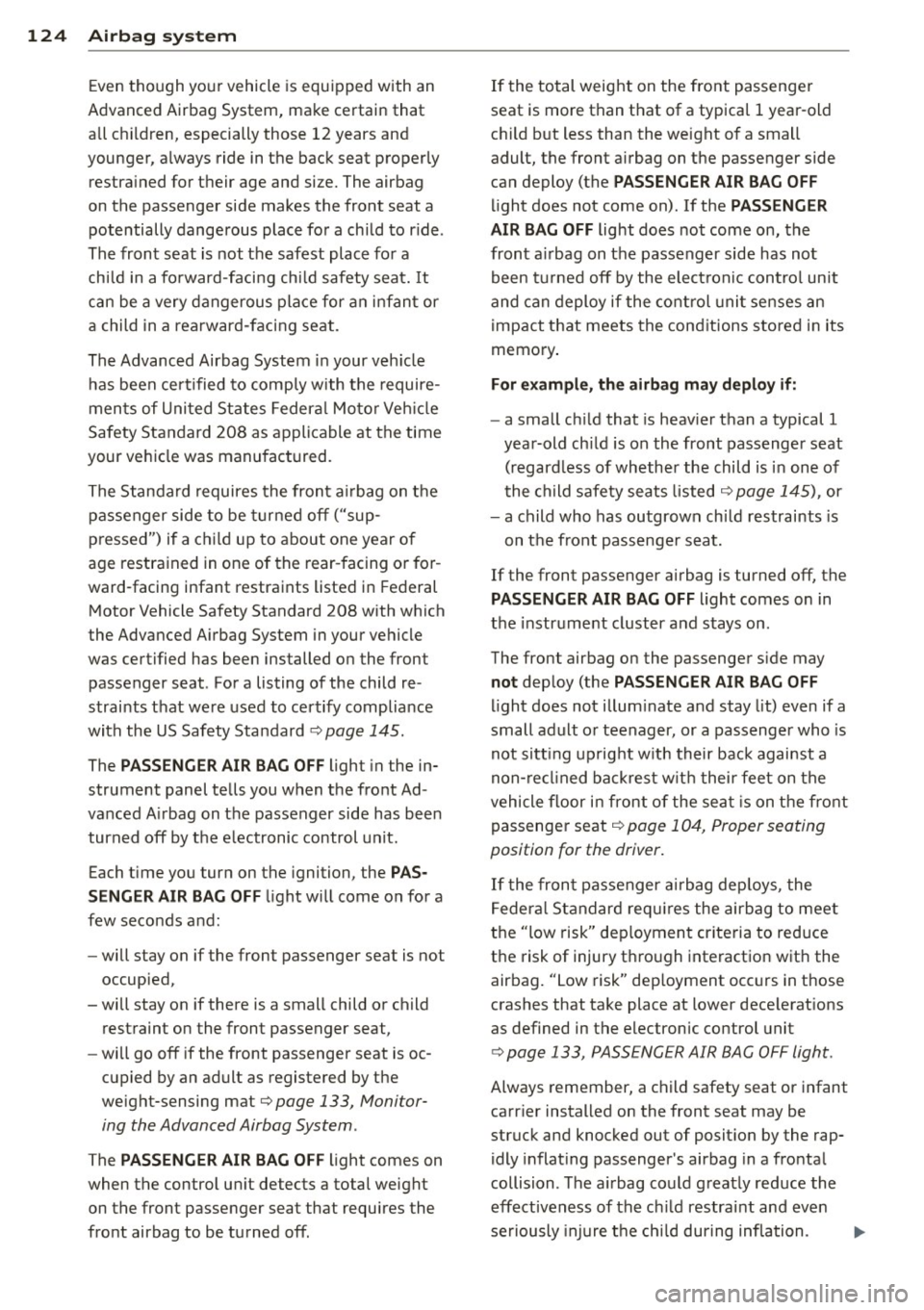
124 Airbag system
Even though your vehicle is equipped with an
Advanced Airbag System, make certain that
all chi ldren, especially those 12 years and
younger, a lways ride in the back seat properly
restrained for their age and size. The airbag
on the passenger side makes the front seat a potentially dangerous place for a ch ild to ride.
The front seat is not the safest place for a
child in a forward-facing child safety seat. It
can be a very dangerous place for an infant or
a child in a rearward-facing seat.
The Advanced Airbag System in your veh icle
has been certified to comply with the require
ments of United States Federal Motor Vehicle
Safety Standard 208 as applicable at the time
your vehicle was manufactured.
The Standard requires the front a irbag on the
passenger side to be turned off ("sup
pressed") if a child up to about one year of
age restrained in one of the rear-facing or for
ward -facing infant restraints listed in Federal
Motor Vehicle Safety Standard 208 with which
the Advanced Airbag System in your vehicle
was certified has been installed on the front passenger seat . For a listing of the child re
strai nts that we re used to certify compliance
with the US Safety Standard
r=v page 145.
The PASSENGER AIR BAG OFF light in the in
strument panel te lls you when the front Ad
vanced A irbag on the passenger side has been
turned off by the e lectronic control unit.
Each t ime you turn on the ignition, the
PAS
SENGER AIR BAG OFF
light will come on for a
few seconds and:
- will stay on if the front passenger seat is not
occupied,
- will stay on if there is a small child or child restraint on the front passenger seat,
- wi ll go off if the front passenger seat is oc
cupied by an adult as registered by the
weight-sensing mat
r=v page 133, Monitor
ing the Advanced Airbag System .
The PASSENGER AIR BAG OFF light comes on
when the control un it detects a total weight
on the front passenger seat that requires the
front airbag to be turned off.
If the total weight on the front passenge r
seat is more than that of a typica l 1 year -old
chi ld but less than the weight of a small
adult, the front airbag on the passenger side
can deploy (the
PASSENGER AIR BAG OFF
light does not come on). If the PASSENGER
AIR BAG OFF
light does not come on, the
front airbag on the passenger side has not
been turned off by the electronic con trol unit
and can deploy if the control unit senses an
impact that meets the cond itions stored in its
memory .
For example, the airbag may deploy if:
-a small ch ild that is heav ier than a typical 1
year-old ch ild is on the front passenger seat
( re gard less of whether the child is in one of
the child safety seats listed
r=v page 145), or
- a child who has outgrown ch ild restraints is
on the front passenger seat.
If the front passenger airbag is turned off, the
PASSENGER AIR BAG OFF light comes on in
the instrument cluster and stays on.
The front airbag on the passenger s ide may
not deploy (the PASSENGER AIR BAG OFF
light does not illum inate and stay lit) even if a
small adult or teenager, or a passenger who is
not sitting upright with their back against a
non-reclined backrest with their feet on the
vehicle floor in front of the seat is on the front
passenger seat
r=v page 104, Proper seating
position for the driver.
If the front passenger airbag deploys, the
Federal Standard requires the airbag to meet
the "low risk" deployment criteria to reduce
the risk of injury t hroug h interaction with the
airbag. "Low risk" deployment occurs in those
crashes that take place at lower dece lerat ions
as defined in the electronic control unit
r=v page 133, PASSENGER AIR BAG OFF light .
Always remember, a child safety seat or infant
carr ier installed on the front seat may be
struck and knocked out of posit ion by the rap
idly inflat ing passenger's airbag in a frontal
collision . The air bag could greatly reduce the
effectiveness of the ch ild restraint and even
seriously injure the child during inflation .
Page 127 of 280
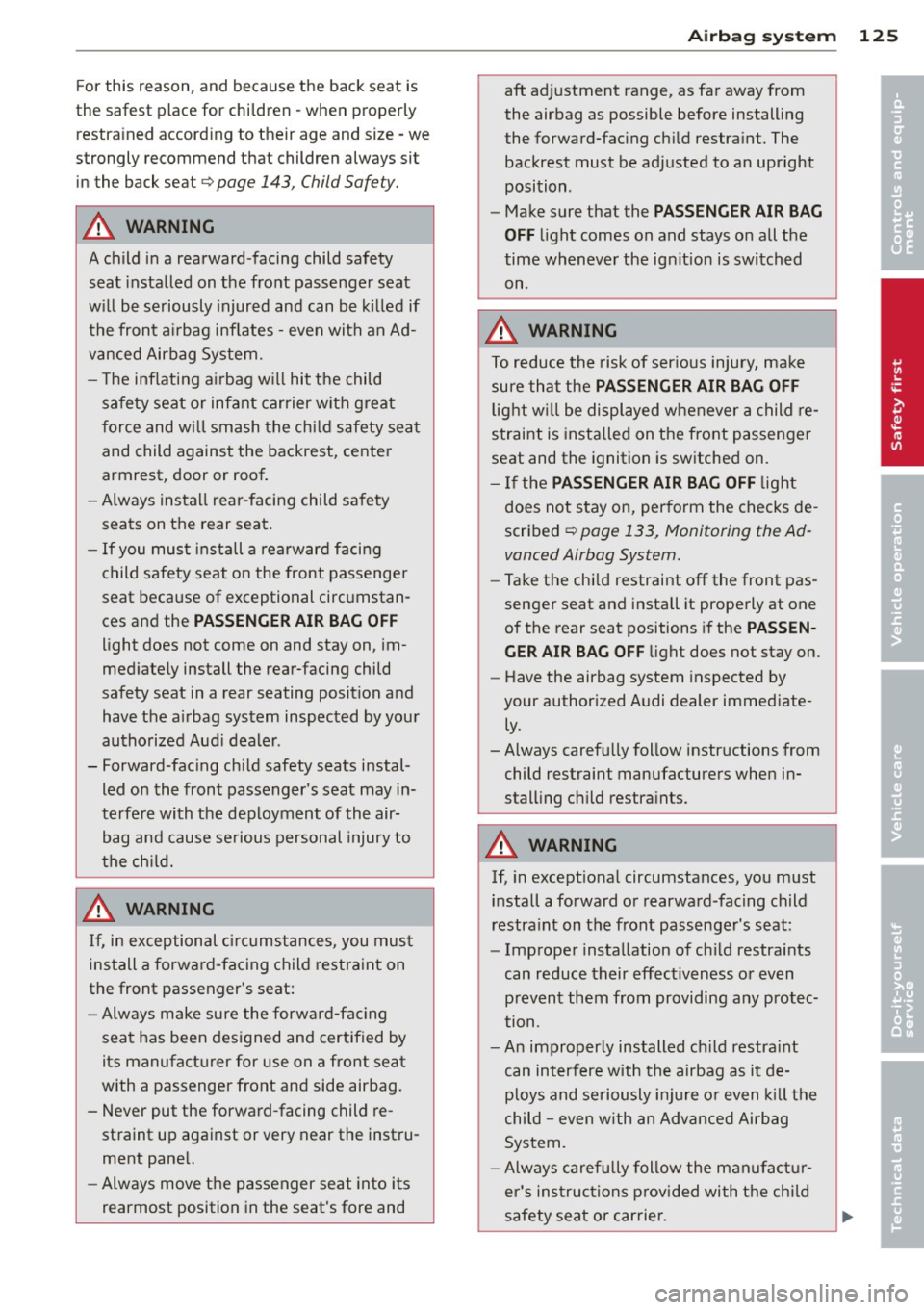
For this reason, and because the back seat is
the safest place for children - when properly restrained according to their age and size - we
strongly recommend that children always sit in the back seat
Q page 143, Child Safety.
A WARNING
-
A child in a rearward-facing child safety seat installed on the front passenger seat
w ill be seriously injured and can be k illed if
the front a irbag inflates - even with an Ad
vanced Airbag System.
- T he inflating a irbag w ill hit the child
safety seat or infant carrier with great
force and w ill smash the ch ild safety sea t
and child against the backrest, cente r
armrest, door or roof .
- Always install rear -facing child safety
seats on the rear seat.
- If you must install a rearward facing
child safety seat on the front passenger
seat because of exceptional circumstan
ces and the
PASSENGER AIR BAG OFF
light does not come on and stay on , im
med iately install the rear-facing child
safety seat in a rear seating posit ion and
have the a irbag system inspected by your
authorized Aud i dealer .
- Forward-fac ing ch ild safety seats instal
led on the front passenger's seat may in
terfe re with the deployment of the air
bag and cause se rious personal injury to
the ch ild.
A WARNING
If, in exceptional c irc umstances, you mus t
install a forwa rd-facing child restra int on
the front passenger's seat:
- Alw ays make sure the forw ard-fac ing
seat has been des igned and certified by
its manufacturer for use on a front seat
with a passenger front and side airbag.
- Never put the forward -facing child re
straint up aga inst or very near the instru
ment pane l.
- Always move the passenger seat into its
rearmost position in the seat's fore and
A irbag system 12 5
aft adjustment range, as far away from
the airbag as possible before installing
the forward-fac ing ch ild restraint. The
backrest must be adj usted to an upright
position .
- Make sure that the
PASSENGER AIR BAG
OFF
li ght comes on and stays on all the
time wheneve r the ignit ion is switched
on.
A WARNING
To reduce the risk of ser ious injury, make
su re that the
PASSENGER AIR BAG OFF
light w ill be displayed whenever a child re
straint is installed on the front passenger
seat and the ignition is switched on.
- If the
PASSENGER AIR BAG OFF light
does not s tay on, per form the checks de
scribed
Q page 133, Monitoring the Ad
vanced Airbag System.
- Take the chi ld restraint off the front pas
senger seat and install it properly at one
of the rear seat positions if the
PASSEN
GER AIR BAG Off light does not stay on.
- Have the airbag system inspected by
your author ized Audi dealer immed iate
ly .
-Always carefu lly follow instr uctions from
child restraint manufacturers when in
stall ing ch ild restra ints .
A WARNING
If, in except iona l circumstances, you must
install a forward or rearward-facing child
restra int on the front passenger's seat :
- Improper instal lation of ch ild restraints
can reduce their effect iveness o r even
prevent them from providing any protec
tion.
- An improper ly installed ch ild restra int
can interfere with the a irbag as it de
ploys and seriously i njure o r even kill the
child -even with an Adv ance d Airbag
System.
- Always carefu lly follow the manu factur
er 's ins truc tions p rov ided with the ch ild
safety seat or car rier . •
•
Page 129 of 280
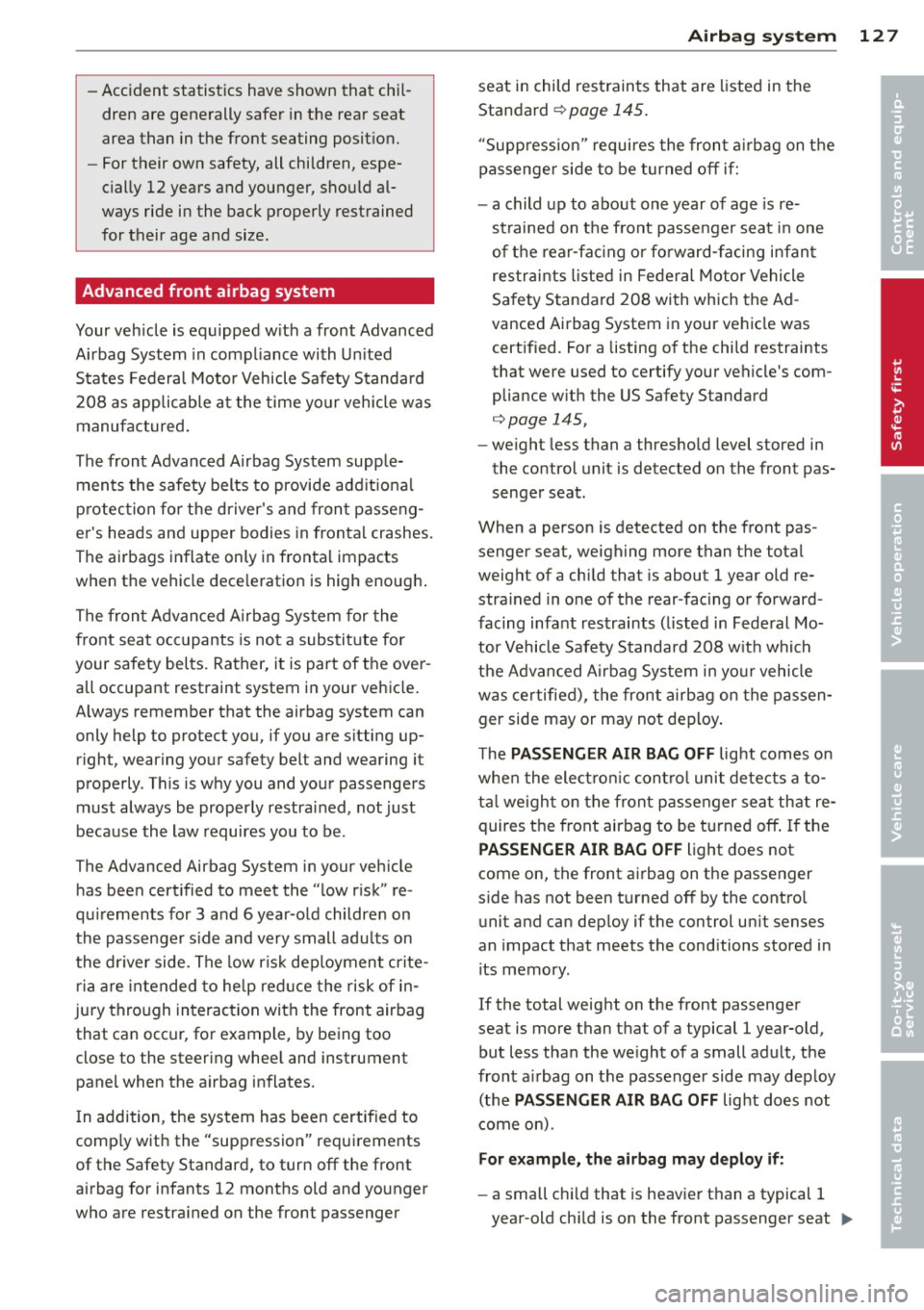
-Accident statistics have shown that chil
dren are generally safer in the rear seat
area than in the front seating posit ion.
- For their own safety, all children, espe
cially 12 years and younger, sho uld al
ways ride in the back properly restrained
for their age and size.
Advanced front airbag system
Your veh icle is equipped w ith a front Advanced
A irbag System in compliance with Un ited
States Federal Motor Vehicle Safety S tanda rd
208 as applicab le a t the time your vehicle was
manufac tured .
The front Advanced Airbag System supple ments the safety belts to provide add it iona l
p rotection fo r the driver's and fron t passeng
e r' s heads and upper bodies in fronta l crashes.
The airbags inflate only in frontal impacts
when the vehicle dece leration is high enough .
The fron t Advanced A irbag Sys tem for the
front seat occ upants is no t a substi tute for
your safety bel ts. Rather, it is part of the over
a ll occupa nt restraint system in your vehicle.
A lways remember that the airbag system can
only help to protect you, if you are s itting up
right, wearing your safety belt and wearing it
properly . This is w hy you and your passenge rs
must always be properly restrai ned, not just
because the law requires you to be .
The Advanced Airbag System i n your veh icle
has been certified to meet the " low r isk" re
qu irements for 3 and 6 year-o ld childre n on
the passenger s ide and very small adu lts on
the dr iver side. The low ris k dep loymen t cr ite
ria are intended to he lp red uce the risk of i n
j ury thro ugh in teraction with the front airbag
that can occ ur, fo r example, by being too
close to the steering whee l and instrument
panel when the airbag inflates.
I n addition, the sys tem has been certif ied to
comp ly with the "suppression" requirements
of the Safety Standard, to turn off the front
airbag for infants 12 months old and younger
who are restra ined on the front passenger
A irbag system 127
seat in child rest raints that are listed in the
Standard
¢ page 145 .
"Supp ress ion" requi res the fron t airbag on t he
passenge r sid e to be turned off if:
- a child up to abo ut one year of age is re
strained on the front passenger seat in one
of t he rear-fa cing o r fo rward -f a cing infan t
res traints listed in Federal Motor Vehicle
Safety Standard 208 with which the Ad
vanced Airbag System in your ve hicle was
cert ified. For a listing o f the chi ld restraints
that were used to certify your vehicle's com
pliance w ith the US Safety Standard
¢page 145,
- weight less than a thresho ld level stored in
the control unit is detected on the front pas
senge r seat.
When a person is detected on the front pas
senger seat, weighing more than the total
weight of a chi ld that is about 1 year old re
stra ined in one of the rear -fac ing or forward
facing infant restraints ( listed in Fede ral Mo
tor Vehicle Safety Standard 208 with whic h
t h e Advanced A irbag Sys tem in yo ur vehicle
was certified), the fron t airbag on the passen
ger side may or may not dep loy .
T he
PASSENGER AIR BAG OFF lig ht comes o n
whe n the elect ro nic cont ro l unit de tects a to
ta l we igh t on the front p assenger sea t that re
quires the front airbag to be t urned off .
If the
PASSENGER AIR BAG OFF light does not
come on, the front ai rbag on the passenger
s ide has not been t urned off by the contro l
u nit and can dep loy if the control un it senses
an impact that meets the cond itions stored i n
its memory .
If the total weight on the front passenger
seat is more than that of a typical 1 year-old,
but less than the we ight of a small adu lt, the
front a irbag on t he passenger side may dep loy
(the
PASSENGER AIR BAG OFF light does not
come on) .
For example, the airbag may deploy if:
-a small chi ld that is heav ie r than a typical 1
year-old ch ild is on the front passenger seat ..,. •
•
Page 130 of 280
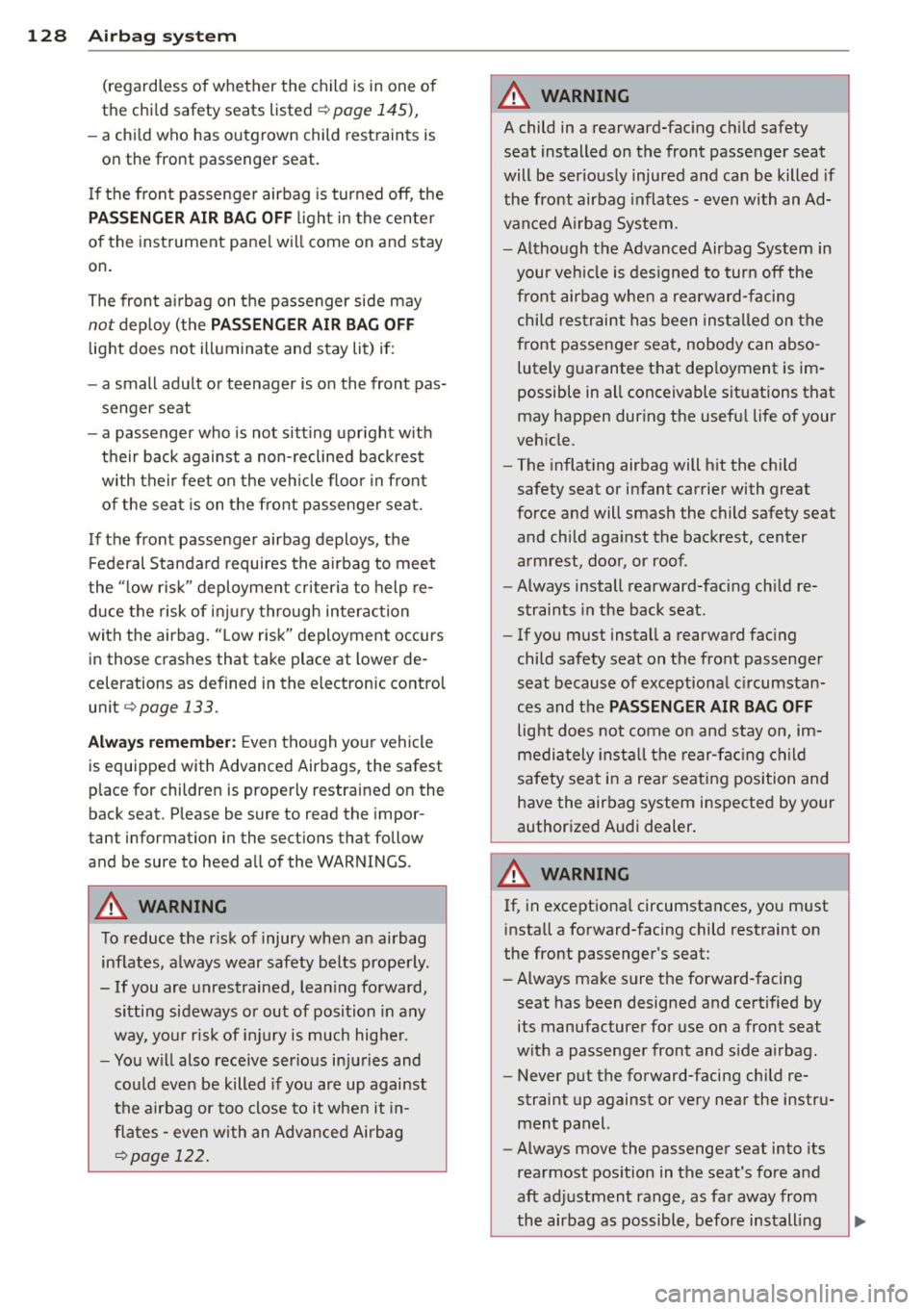
128 Airbag sys tem
(regar dless of whe ther the chil d is in one of
the ch ild safety seats listed
¢ pa ge 14 5),
- a chi ld w ho has outgrown child rest raints is
on the front passenger seat.
I f the front passenger airbag is turned
off , the
PASSEN GER AIR BA G OFF light in the cen ter
of the instrument pane l will come on and stay
on.
The front a irbag on the passenger side may
not deploy (the PA SSENGER AIR BAG OFF
light does not illuminate and stay lit) if:
- a small adu lt or teenager is o n the front pas
senger seat
- a passenger who is not sitt ing upr ight w ith
their back against a non-reclined backrest
with their feet on the veh icle floo r in front
of the sea t is on the front passenger seat.
I f the front passenger airbag deploys, the
F ederal Standard requires the airbag to meet
the " low risk " deployment criteria to help re
d uce the risk of in jury through in terac tion
with the airbag. " Low risk" deployment occurs
in those crashes that take place at lower de
celerations as defined in the e lectronic contro l
un it
q page 133.
Alwa ys remember: Even tho ugh you r vehicle
is equipped with Advanced Airbags, the safest
p lace for children is properly restrained on the
back seat. Please be sure to read the impo r
tant information in the sect ions that follow
and be sure to heed a ll of the WARNINGS .
A WARNING
To reduce the risk of injury when an airbag
inflates, a lways wear safety belts prope rly .
- If you are unrestrained, lean ing forward,
sitting sideways or out of position in any
way, your risk of injury is much higher.
- You w ill also receive serio us in juries and
cou ld even be killed if you are up against
the a irbag or too close to it when it in
fla tes - even with an Adv ance d Airbag
qpage 122.
A WARNING
A child in a rearward-fac ing ch ild safety
seat installed on the front passenger seat
will be serious ly injured and can be killed if
the front airbag inflates - even with an Ad
van ced A irbag System.
- Altho ugh the Advanced Airbag System in
your veh icle is designed to tur n
off the
front air bag when a rearward-facing
child res traint has been instal le d on the
front passenger seat, nobody can abso
lutely g uarantee that dep loyment is im
possible in all conceivable situations that
may happen dur ing the usefu l life of your
veh icle.
- The inflating airbag will h it the ch ild
safety seat or infant carrier with great
force and will smash the child safety seat
and child aga inst the backrest, center
armrest, doo r, or roof.
- Always install rearward-facing ch ild re
straints in the back seat.
- If you must install a rearward fac ing
child safety seat on the front passenger
seat because of exceptiona l circumstan
ces and t he
PASSENGER AIR BAG OFF
light does not come on and s tay on, im
mediately inst all the rear-fac ing c hild
safety seat in a rear seating position and
have the air bag system inspected by your
author ized Audi dealer .
A_ WARNING
If, in exceptiona l circumstances, you m ust
i nsta ll a forward-facing child restraint on
the front passenger's seat:
- Always make sure the forward-facing
seat has been designed and certified by its manufacturer for use on a front seat
with a passenger front and s ide a irbag .
- Never p ut the fo rward-facing child re
straint up against or very near the instru
ment panel.
- Always move the passenger seat into its
rearmost pos ition in the seat's fore and
aft ad justmen t range, as fa r away from
the airbag as possible, before ins talling
Page 131 of 280

the forward-facing child restraint. The backrest must be adjusted to an upr ight
posit ion.
- Make sure that the
PASSENG ER AI R BA G
OFF
light comes on and stays on all the
t ime whenever the ignition is switched
on.
Advanced Airbag System components
The front passenger seat in your vehicle has a
l ot of very important parts of the Advanced
Airbag System in it. These parts include the
weight-sens ing ma t, sensors, wiring, brack
ets, and mo re. The function of the system in
the front passenger seat is checked by the
e lectronic control unit when the ignition is on .
The control unit monitors the Advanced Air bag System and turns the airbag indicator
light on when a malfunction in the system
components is detected. The function of the
airbag ind icator light is described in greater
deta il below. Because the front passenger
seat contains impo rtant parts of the Ad
vanced A irbag System, you m ust take care to
p revent it from being damaged. Damage to
the seat may prevent the Advanced Airbag for
the front passenger seat from doing its job in
a crash .
The front Advanc ed Airbag Syst em
con sis ts o f th e following :
-Crash sensors in the front of the vehicle that
measure vehicle acceleration/deceleration
to provide information to the Advanced Air bag System about the severity of the crash.
-An electronic control unit, with integrated
crash sensors for front and side impacts .
The cont ro l unit "decides" whether to fire
the front airbags based on the information r eceived from the c rash sensors. The control
unit a lso "dec ides" whet her the safety be lt
pretensione rs should be activated.
- An Advanced Airbag with gas generator for
the d river ins ide the steer ing whee l hub.
- An Advanced Airbag with gas generator in
s ide t he instr ument pane l for the front pas
senger.
A irbag system 129
- A weight-sensing mat under the upho lstery
padding of the front passenger seat cushion
that measures the total weight on the seat .
The informat ion reg istered is sent continu
ously to the electron ic control unit to regu
late deployment of the front Advanced Air
bag on the passenger side.
- An airbag monitoring system and ind icator
light in the instrument cluster
¢page 133.
-The PASSENGER AIR BAG OFF light comes
on and stays on in the center of the instru
ment panel
c:::> page 133, fig . 134 and tells
you when the front Advanced Airbag on the passe nger side has been tu rned off.
- A senso r below the safety belt latch fo r the
front seat passenger to measure the tension
on the safety be lt. T he ten sion on the safety
be lt and the weight regis tered by the
weight -sensing mat he lp the control unit
"decide" whether the front airbag fo r the
front passenger seat should be turned off or not
¢ page 123, Child restraints on the
front seat -some important things to
know.
-A sensor in the safety belt latch for the driv
er and for the front seat passenger that
senses whether that safety belt is latched or
not and transmits this information to the
electronic contro l un it .
A WARNING
D amage to the front passenger seat can
p revent the front airbag from wor king
properly.
- Imp roper repai r or d isassembly of the
fr on t passenge r and dr iver seat will pre
vent the Advanced Airbag System from
functioning p roperly.
- Repairs to the front passenger seat must
be pe rformed by qualified and p roperly
trained workshop personne l.
- Never remove the front passenger or driver seat from the vehicle .
- Never remove the upho lstery from the
front passenger seat .
- Never disassemble or remove p arts from
-
the sea t or disconnect wires from it. ..,.
•
•
Page 132 of 280

130 Airbag system
-Never carry sharp objects in your pockets
or place them on the seat. If the weight
sensing mat in the passenger seat is
punctured it cannot work properly .
- Never carry things on your lap or carry
objects on the passenger seat. Such items can increase the weight registered
by the weight-sensing mat and send the
wrong information to the airbag control
unit.
- Never store items under the front pas
senger seat. Parts of the Advanced Air
bag System under the passenger seat
could be damaged, preventing them and
the airbag system from working proper
ly.
- Never place seat covers or replacement
upholstery that have not been specifical
ly approved by Audi on the front seats.
- Seat covers can prevent the Advanced Airbag System from recognizing child re
straints or occupants on the front pas
senger seat and prevent the side airbag
in the seat backrest from deploying prop
erly .
- Never use cushions, pillows, blankets or
similar items on the front passenger
seat. The additional padding will prevent
the weight-sensing mat in the seat from
accurately registering the child restraint
or person on the seat and prevent the
Advanced Airbag System from function
ing properly.
- If you must use a child restraint on the
front passenger seat and the child re
straint manufacturer's instructions re
quire the use of a towel, foam cushion or
something else to properly position the
child restraint, make certain that the
PASSENGER AIR BAG OFF light comes
on and stays on whenever the child re
straint is installed on the front passen ger seat .
- If the
PASSENGER AIR BAG OFF light
does not come on and stay on, immedi
ately install child restraint in a rear seat
ing position and have the airbag system
inspected by your authorized Audi dealer.
How the Advanced Airbag System
components work together
The front Advanced Airbag System and the
side airbags supplement the protection of
fered by the front three-point safety belts
with pretensioners and load limiters and the
adjustable head restraints to help reduce the
risk of injury in a wide range of accident and
crash situations. Be sure to read the impor
tant information about safety and heed the
WARNINGS in this chapter.
Deployment of the Adva need Airbag System
and the activation of the safety belt preten
sioners depend on the deceleration measured
by the crash sensors and registered by the
electronic control unit. Crash severity depends
on speed and deceleration as well as the mass
and stiffness of the vehicle or object involved
in the crash.
When the electronic control unit registers a
low severity crash and the safety belt is being
used , the airbag will not deploy. If the safety
belt is not being used, the first stage deploys,
followed by the second stage after a much lat
er time in the crash sequence.
If the electronic control unit registers a crash
of medium severity, the first stage of the air
bag deploys followed by the second stage at a
much later time in the crash sequence - re
gardless of whether the safety belt is being
used or not . In higher severity crashes as reg
istered by the electronic control unit, both the
first and second stages deploy almost at the same time.
On the passenger side, regardless of safety
belt use, the airbag will be turned off if the
weight on the passenger seat is less than the
amount programmed in the electronic control
unit. The front airbag on the passenger side
will also be turned off if one of the child safe
ty seats that has been certified under Federal
Motor Vehicle Safety Standard 208 has been
recognized on the seat. The
PASSENGER AIR
BAG OFF
light comes on and stays on to tell
you when the front Advanced Airbag on the passenger side has been turned off ..,_
Page 133 of 280
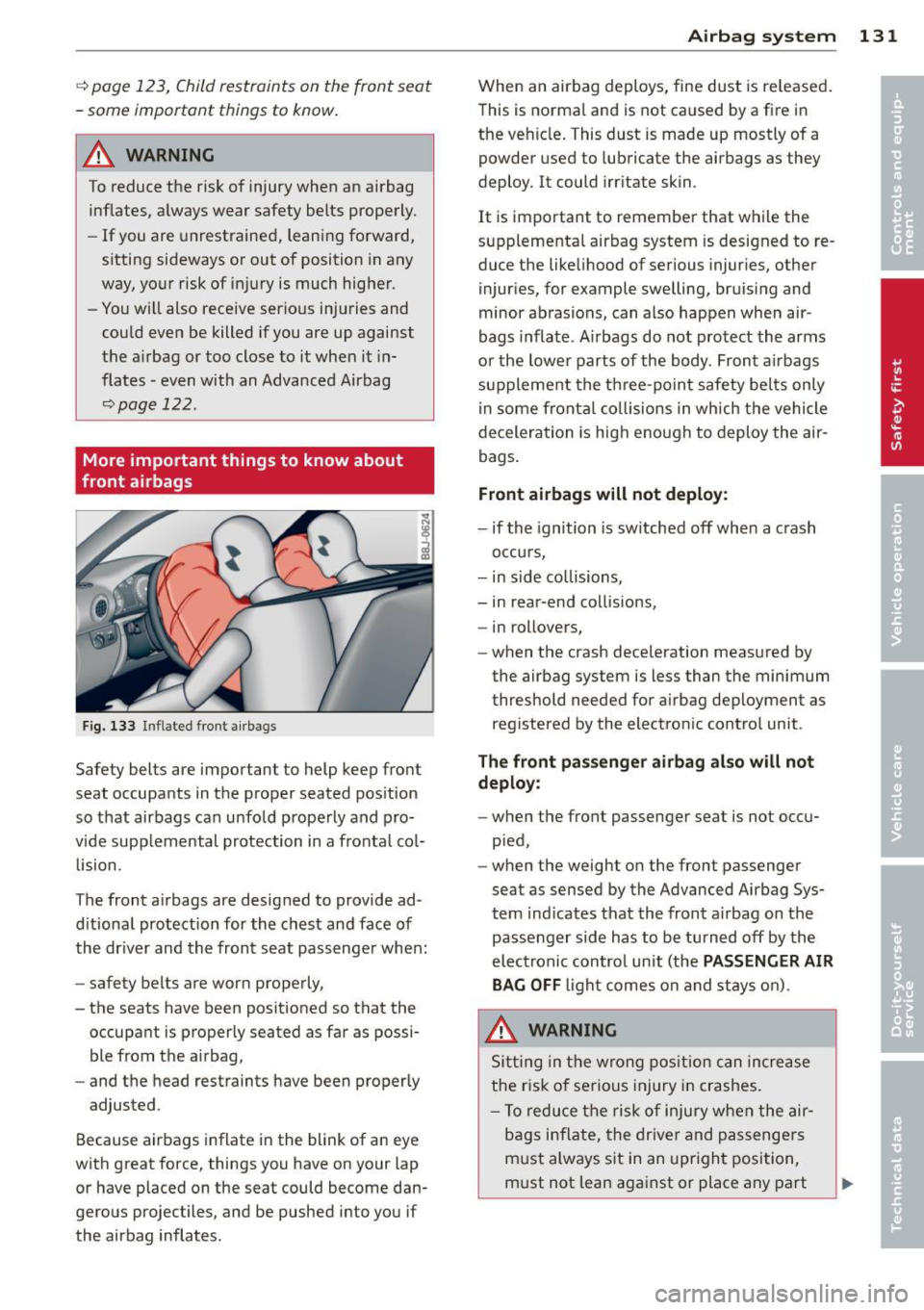
¢ page 123, Child restraints on the front seat
- some important things to know .
A WARNING
To reduce the risk of injury when an airbag
inflates, always wear safety belts properly.
- If you are unrestrained, lean ing forward,
sitting sideways or out of position in any
way, your risk of injury is much higher.
- You w ill also receive serious injuries and
cou ld even be killed if you are up against
the a irbag or too close to it when it in
flates - even with an Advanced Airbag
~ page 122.
More important things to know about
front airbags
F ig. 133 Inflated front a irbags
Safety belts are important to help keep front
seat occupants in the proper seated pos ition
so that airbags can unfold properly and pro
vide supp lemental protection in a fronta l co l
lision .
The front a irbags are designed to provide ad
d itiona l protection for the chest and face of
the dr iver and the front seat passenger when :
- safety belts are worn properly,
- the seats have been positioned so that the occupant is properly seated as far as possi
ble from the a irbag,
- and the head restraints have been proper ly
adjusted .
Because airbags i nflate in the blink of an eye
with great force, things you have on your lap or have placed on the seat could become dan
gerous projectiles, and be pushed into you if
the airbag inflates.
A irba g sy stem 131
When an airbag deploys, fine dust is re leased.
This is norma l and is not caused by a fire in
the vehicle . This dust is made up mostly of a
powder used to lubricate the airbags as they
deploy. It could irritate skin .
It is important to remember that whi le the
supplementa l airbag system is designed to re
duce the like lihood of serious injuries, other
injur ies, for example swelling, bruising and
minor abras ions, can also happen when air
bags i nflate. A irbags do not protect the arms
or the lower parts of the body . Front a irbags
supplement the th ree -po in t safety belts only
in some fronta l co llisions in which the vehicle
deceleration is high enough to deploy the air
bags .
Front airbags will not deploy :
-if the ignition is sw itched off when a crash
o ccu rs,
- in side co llisions,
- in rear-end collisions,
- in rollovers,
- when the crash dece leration measured by
the airbag system is less than the minimum
threshold needed for a irbag deployment as
reg istered by the electron ic contro l unit .
The f ront pa ssen ger airbag als o will no t
deplo y:
- when the front passenger seat is not occu
pied,
- when the weight on the front passenger
seat as sensed by the Advanced Airbag Sys
tem ind icates that the front a irbag on the
passenger side has to be tu rned off by the
electronic contro l un it (the
PASSENGER AIR
BA G OFF
light comes on and stays o n).
.&, WARNING
Sitting in t he wrong pos ition can increase
the risk of serious injury in crashes.
- T o reduce the risk of injury when the air
bags inflate, the driver and passenge rs
m ust always s it in an upright position,
m ust not lean against or place any part
Page 134 of 280
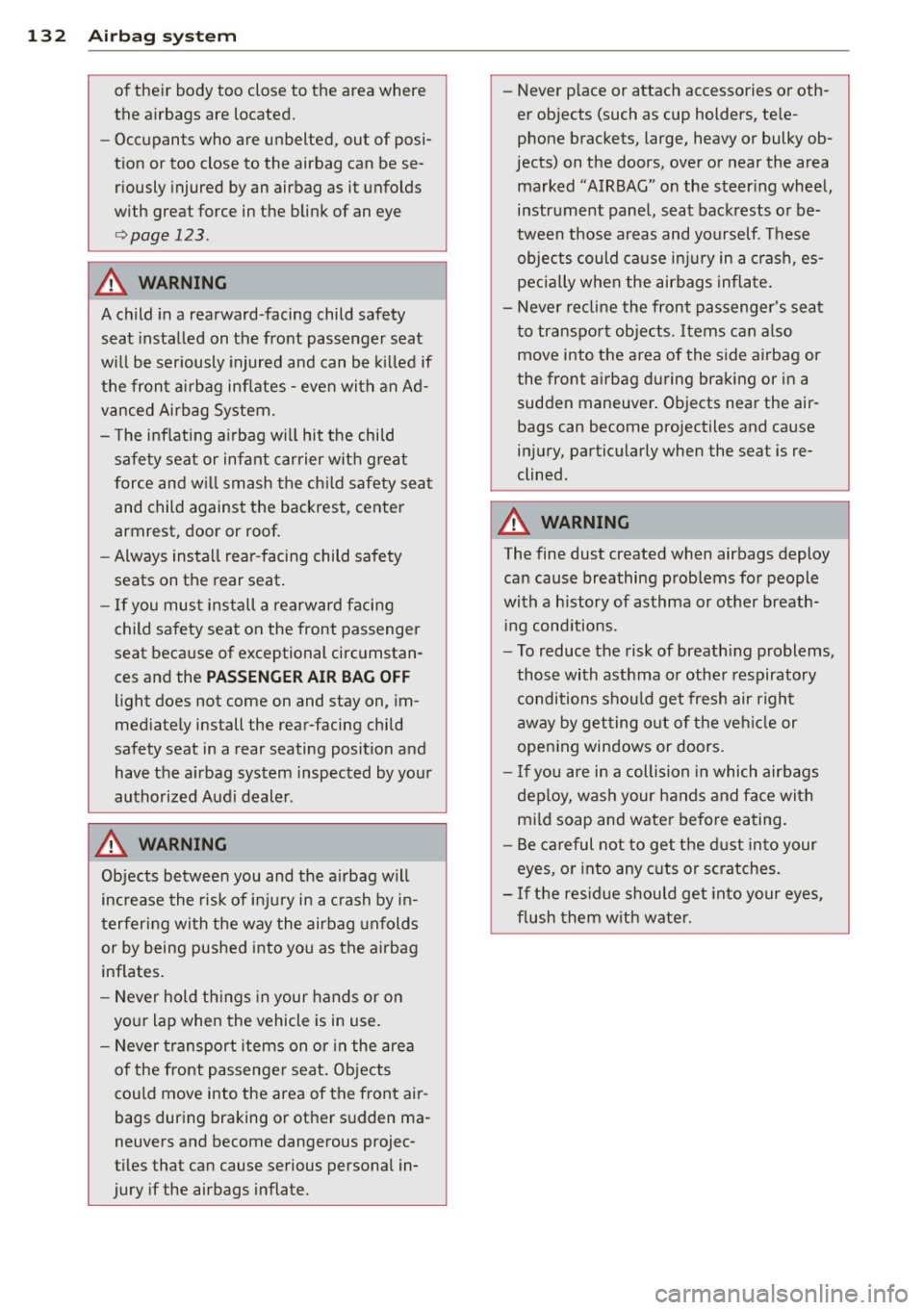
132 Airbag system
of their body too close to the area where
the airbags are located.
- Occupants who are unbelted, out of posi
tion or too close to the airbag can be se riously injured by an airbag as it unfolds
with great force in the blink of an eye
r=> page 123 .
A WARNING
A child in a rearward-facing child safety
seat installed on the front passenger seat
will be seriously injured and can be killed if
the front airbag inflates -even with an Ad
vanced Airbag System.
- The inflating airbag will hit the child
safety seat or infant carrier with great
force and will smash the child safety seat
and child against the backrest, center armrest, door or roof.
- Always install rear-facing child safety
seats on the rear seat.
- If you must install a rearward facing
child safety seat on the front passenger
seat because of exceptional circumstan ·
ces and the
PASSENGER AIR BAG OFF
light does not come on and stay on, im
mediately install the rear-facing child
safety seat in a rear seating position and
have the airbag system inspected by your
authorized Audi dealer .
A WARNING
Objects between you and the airbag will
increase the risk of injury in a crash by in
terfering with the way the airbag unfolds
or by being pushed into you as the airbag
inflates.
- Never hold things in your hands or on
your lap when the vehicle is in use .
- Never transport items on or in the area
of the front passenger seat. Objects
could move into the area of the front air
bags during braking or other sudden ma
neuvers and become dangerous projec
tiles that can cause serious personal in
jury if the airbags inflate.
-
- Never place or attach accessories or oth
er objects (such as cup holders, tele
phone brackets, large, heavy or bulky ob
jects) on the doors, over or near the area
marked "AIRBAG" on the steering wheel,
instrument panel, seat backrests or be
tween those areas and yourself . These
objects could cause injury in a crash, es
pecially when the airbags inflate.
- Never recline the front passenger's seat
to transport objects. Items can also
move into the area of the side airbag or
the front airbag during brak ing or in a
sudden maneuver. Objects near the air
bags can become projectiles and cause
injury, particularly when the seat is re
clined.
A WARNING
-T he fine dust created when airbags deploy
can cause breathing problems for people
with a history of asthma or other breath
ing conditions.
= To reduce the risk of breathing problems ,
those with asthma or other respiratory
conditions should get fresh air right
away by getting out of the vehicle or
opening windows or doors.
- If you are in a collision in which airbags
deploy, wash your hands and face with
mild soap and water before eating.
- Be careful not to get the dust into your
eyes, or into any cuts or scratches.
- If the residue should get into your eyes ,
flush them with water.